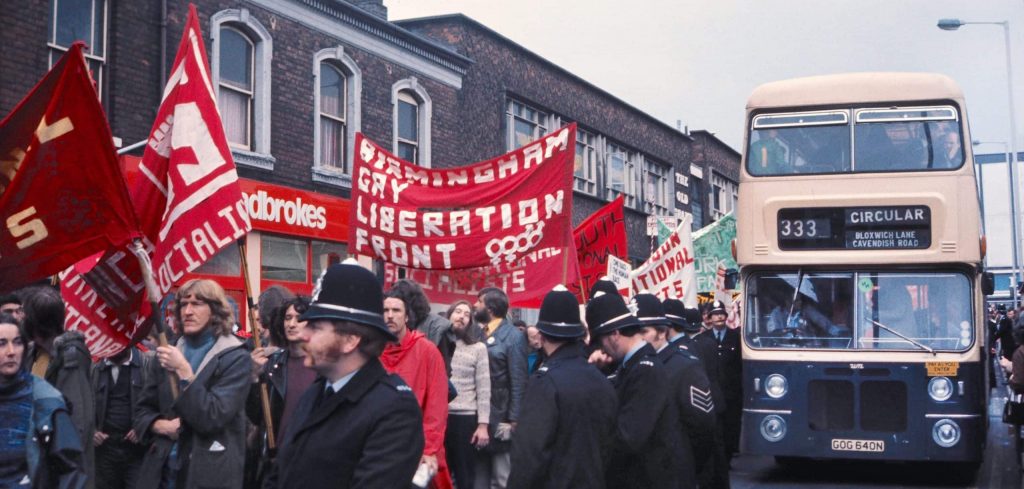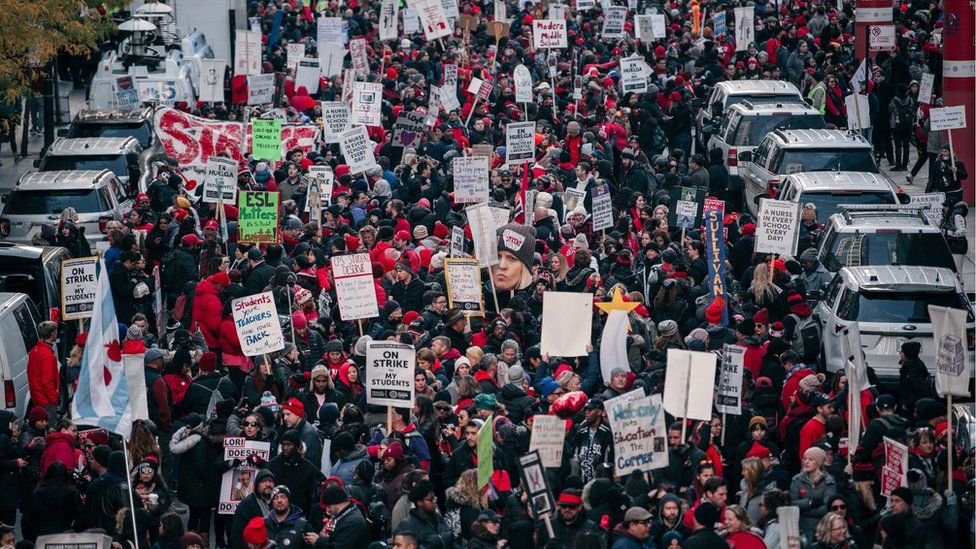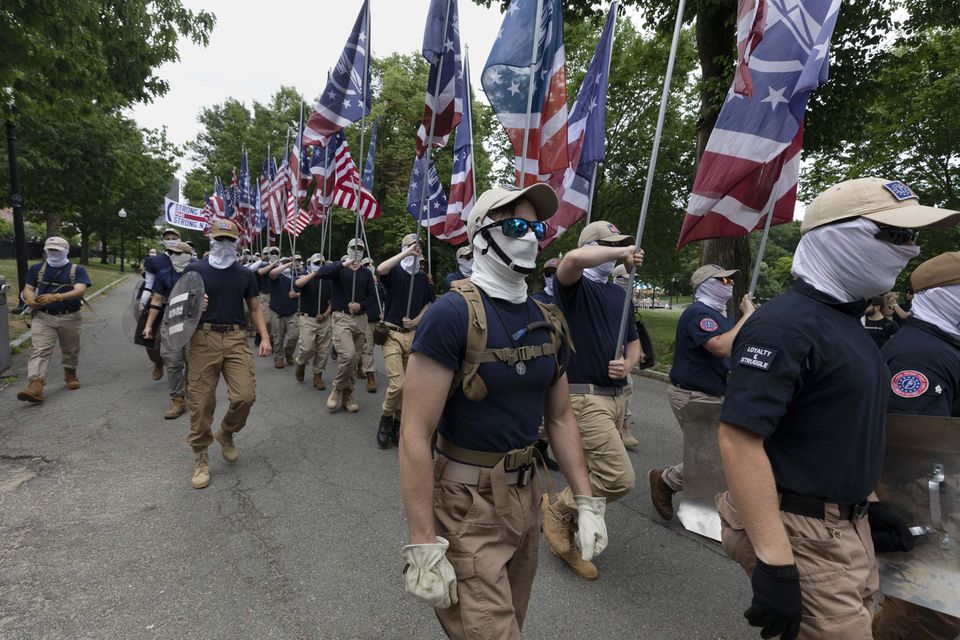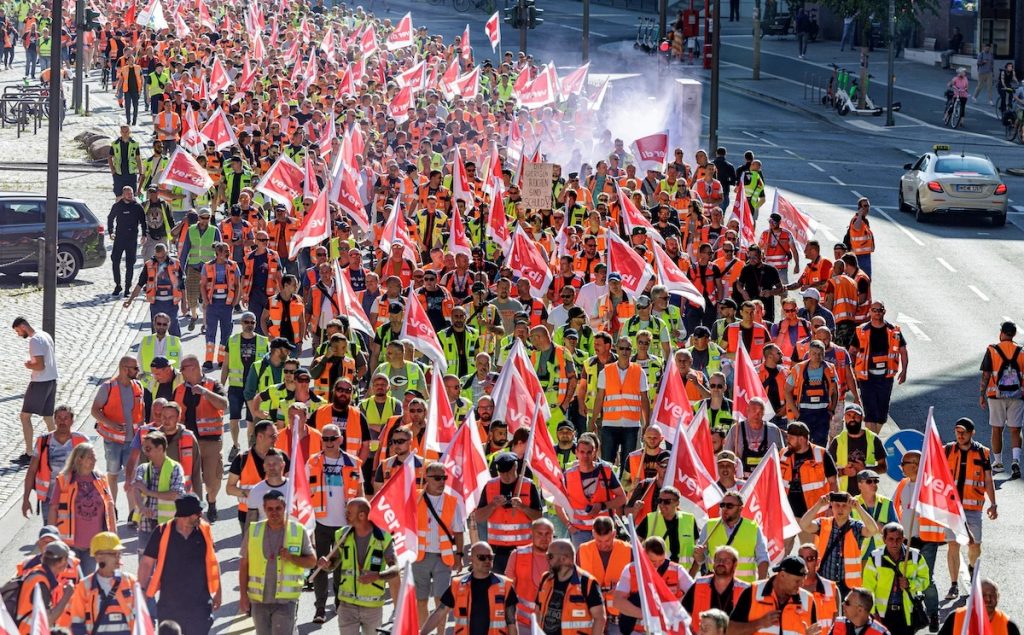
Marxism, Stalinism, and Queerphobia
A historical survey of Marxism and queer life, from the young Soviet Union to Stalinist homophobia.
Von Marco Helmbrecht and Niko Weber July 17, 2022
For decades, common sense dictated that Marxism focused solely on class antagonisms and ignored other forms of oppression, like the oppression of women, people of color, and LGBTQ+ people. Indeed, many of those claiming the mantle of Marxism, from those in the Stalinist tradition to the social democratic tradition — including even the present-day Democratic Socialists of America — downplayed the importance of special oppression and maintained an economistic strategy that benefited only the upper strata of the working class. But the reactionary positions of Stalinism and social democracy on sexual and gender oppression do not reflect the legacy of Marxism in the slightest, as a look into the history of the revolutionary workers movement shows. Rather, revolutionary socialism in Russia, with the October Revolution, led the way toward a radical change in the material and ideological foundations of LGBTQ+ discrimination. Reactionary deviations occurred when parties and organizations, despite their socialist self-image, abandoned the revolutionary horizon and tried to come to terms with the capitalist world. This historical insight can help us clarify what kind of politics we need for emancipation today with a new onslaught of attacks on the rights of queer people, particularly in the United States, the world’s most advanced capitalist “democracy.”
The Bolshevik Advance
In the second half of the 19th century, a gay scene formed in Russia’s two most important cities, Saint Petersburg and Moscow. It created places for socializing, such as bathhouses; linguistic codes (tetki, which roughly translates as “auntie,” a word that was applied to homosexual men, both by them and others); elements of a dress code; and, at least in private spaces, cross-dressing. As historian Dan Healey describes in his influential work on the history of homosexuality in revolutionary Russia and the Soviet Union, Homosexual Desire in Revolutionary Russia, it would be “heterosexist and nationalist chauvinism to claim that in tsarist Russia or in the USSR, this homosexual subculture was imported from abroad or created by Communist misrule.”1
At the same time, same-sex intercourse between men was illegal under the rules of the Orthodox Church. Until 1917, consensual “sodomy” was punishable by exile to Siberia. But the this threat was unevenly realized. The abolition of the czarist legal codes in 1917 meant the de facto decriminalization of homosexuality, and with the adoption of a new code in 1922, references to “sodomy” disappeared from the official legal texts of the young Soviet state. After revolutionary 18th-century France, the Soviet Union was thus one of the first states in the world to legalize homosexuality. In the Weimar Republic, meanwhile, the infamous paragraph 175 from the Kaiserreich, criminalizing homosexuality, remained in force before it was tightened under fascism and ultimately abolished in the Federal Republic only in 1994 — a lifetime after decriminalization in the Soviet Union.
Women who entered into romantic or sexual relationships with other women had less access to the public sphere in Russia and accordingly found it more difficult to form a cohesive community. Fewer sources exist on this issue, since same-sex intercourse between women was not punishable and therefore does not show up, for instance, in court records. Nevertheless, economically independent women in particular succeeded in forming networks and entering into relationships beyond the traditional heterosexual family. In the military climate of the Civil War years after the October Revolution, many women adopted a masculine style, which on the one hand signaled a loyalty to the Revolution and a willingness to defend it, but on the other hand could also be code for homosexual women to attract other women. The lines to transsexuality were blurry sometimes. In response to a survey on sexuality at Moscow’s Sverdlov University in 1923, one answer was “I want to be a man, I impatiently await scientific discoveries of castration and grafting of male organs (glands).”2 Such operations were indeed performed in the 1920s, even if their success was doubtful owing to still rudimentary methods. Even apart from medical interventions, many took advantage of the opportunity to change their gender identity. They had appropriate identification documents issued, adopted male variants of their old names, and changed their clothing and appearance. This was accompanied by lively scientific debates about the origin and nature of homosexuality and gender, which were widely considered to be closely related. Biologist Nikolai Konstantinovich Koltsov asserted, “Of course, there is no intermediate sex, but rather an infinite quantity of intermediate sexes.”3
Evgenii Fedorovich M. began to assume a male identity in 1915, when he was 17 years old. During the revolution he had his name changed in the official documents and began to work in the secret service. In 1922, with the new documents, Yevgeny married a woman who, in the sources, is named S. Even after the change of identity became known; a local court case in which the couple stood accused of a “crime against nature” failed, and the marriage persisted. The court ruled the union legal because it was mutually consensual — the gender identity of the spouses was irrelevant. The couple continued to live together as a family for several years with a child that S. gave birth to after an affair with a colleague.4 The revolutionary awakening and the rejection of traditional norms were not only represented by elite Bolsheviks but also allowed people like Yevgeny an unprecedented degree of self-determination.
Bourgeois historical scholarship has occasionally claimed that the Bolsheviks did not intend to legalize homosexuality at all by abolishing the czarist legal codes. Simon Karlinsky, for example, claimed that the October Revolution reversed and negated the advances for gay rights achieved in the revolutions of 1905 and of February 1917, passing over the first decriminalization of “sodomy” as an aside.5 Healey, however, comes to the following, unequivocal conclusion based on the files of the Commissariat of Justice, which became accessible with the opening of the Soviet archives in 1991:
While these documents do not discuss the sodomy statute in detail, they do demonstrate a principled intent to decriminalize the act between consenting adults, expressed from the earliest efforts to write a socialist criminal code in 1918 to the eventual adoption of legislation in 1922.6
By decriminalizing male homosexuality, the Bolsheviks stood in the long tradition of the labor movement. In 1898, for example, the leader of the German Social Democrats, August Bebel, had been the first politician to call for homosexual emancipation in a parliament. Three years earlier, socialists had defended the famous writer Oscar Wilde when he was put on trial for his homosexuality. Eduard Bernstein sharply criticized the idea that homosexuality deviated from “nature,” proposing instead that it be understood as a deviation from “the firmly maintained fictional norm,” and holding that “there is no reasonable ground why a similar contract between man and man should be criminally punished.”7 Socialists were not the only ones to call for the legalization of homosexuality. After the October Revolution, however, they not only raised the demand but actually put it into practice.
The pamphlet “The Sexual Revolution in Russia,” written in 1923 by the head of the Moscow Institute of Social Hygiene, Dr. Grigorii Batkis, gives an impression of the official position of the Bolsheviks in the first years after the revolution. In it he writes,
[Soviet legislation] declares the absolute noninterference of the state and society into sexual matters, so long as nobody is injured, and no one’s interests are encroached upon. Concerning homosexuality, sodomy, and various other forms of sexual gratification, which are set down in European legislation as offenses against public morality — Soviet legislation treats these exactly the same as so-called “natural” intercourse. All forms of sexual intercourse are private matters.8
Of course, in the young Soviet Union, not all the prejudices were eliminated from one day to the next. They had become ingrained in decades and centuries of tsarist backwardness. Moreover, the legalization policy of the Bolsheviks did not extend to the entire area of the Soviet Union. The code of the Uzbek SSR, for example, which was established in 1926, still contained paragraphs against homosexuality. While in the European center of the country, homosexuality was understood as an innate characteristic of a minority; in the periphery it was conceived of as a widespread phenomenon arising from social conditions. Healey calls this a “contradiction between the Soviet Union’s declared sexual vanguardism and its policies in outlying regions.”9 Furthermore, during the 1920s, access to ballrooms and meeting halls in the urban centers dwindled more and more, which, according to a common interpretation, led to a retreat into the private sphere. This is contradicted, however, by the fact that homosexual men played important public roles in the young Soviet republic. Author Mikhail Kuzmin, who came from an aristocratic background and wrote the first coming-out novel affirming homosexuality, Wings, in 1906, sympathized with the revolution and served as chairman of the Petrograd Artists’ Association. Kuzmin was friends with the openly gay Georgy Chicherin, who served as People’s Commissar for Foreign Affairs, a post that was roughly equal to a Soviet foreign minister, from 1918 to 1930.
A few isolated statements by Lenin are often used to argue that the Bolsheviks allegedly took a prudish position on questions of sexuality. In correspondence with the French socialist Inessa Armand in 1915, he defended himself against the demand for a “freedom of love.”10 In a few lines, he argued that freedom from material calculations, religious prejudices, or “from the fetters of the law, the courts and the police” would be poorly expressed by this phrase and could also be understood to mean freedom “from the serious element in love” or “from childbirth,” which he described as a bourgeois demand. Healey, too, infers from these lines (and from similar statements attributed to Lenin after his death by Clara Zetkin11) that Lenin may well have meant to say that those suffering from a “personal abnormality” in their sexual lives should do so in private while devoting themselves to the revolution.12 Sherry Wolf strongly rejects this “rather stilted reading of Lenin’s thoughts” in Sexuality and Socialism, arguing that it conforms to the Cold War caricature of Lenin as a teetotaling ascetic.13 In fact, Lenin’s letters to Armand were not published until 1939 under Stalin to signal, as Healey himself writes in a footnote, that the “changes to family policy in the 1930s had Leninist origins.”14
The Stalinist Rollback
Contrary to the hopes of the Bolsheviks, by 1923, no further socialist states had emerged from the European revolutionary upsurge after World War I. In capitalist encirclement, material deprivation after years of first world and then civil war, and the resulting massive attenuation of the Soviet industrial proletariat, an extensive bureaucracy had taken hold in all areas of administration, attempting to elevate the country’s isolation to the status of theory with “socialism in one country.”
The bureaucracy’s interest in self-preservation, coexisting with the capitalist West, was matched by an increased demand for labor, which led to a policy of increasing the birth rate. Efforts to abolish the family, whose tasks for social reproduction were to be made superfluous through the establishment of public child care, laundry shop, or state canteens, were replaced by the consolidation of traditional family and gender norms. In a trade union newspaper, Aron Solz, who had held leading posts in the Soviet judiciary before being ousted in 1938, wrote: “A Soviet woman has equal rights with a man, but she is not relieved of the great and honorable natural duty: she’s a mother, she gives life.”15
The ideological justification for the renewed criminalization of homosexuality was provided in 1934 by Stalin’s mouthpiece on cultural issues, the author Maxim Gorky. He attributed to homosexuality a corrupting influence on youth and contrasted the myth of Russian “purity” with the decay of the “overcivilized” West, which, supposedly, along with homosexuality, also gave rise to fascism. His utterance culminates in the infamous statement: “Destroy the homosexuals — Fascism will disappear.”16
Just as the decriminalization of homosexuality in 1922 had been part of a broader effort to overcome any form of oppression based on gender or sexuality, the counterreforms of the 1930s were also not limited to reintroducing the persecution of homosexuality. Prostitution was also recriminalized, abortions banned, and the women’s section of the party’s Central Committee dissolved. Leon Trotsky described this policy of prohibitions as “the philosophy of a priest endowed also with the powers of a gendarme.”17 This turn toward a cult of motherhood was accompanied by the cruel persecution of any real or imagined political opposition. In her book Bread and Roses, Andrea D’Atri describes, in relation to women’s politics, the discontinuity between the first decrees of the nascent workers’ state and the outrageous later provisions of the bureaucracy. For the bureaucracy, it was clear: “The revolution needed to be opposed with a counterrevolution.”18 This rupture was enforced with the deportation, imprisonment, torture, and murder of countless people.
With the help of the Comintern, which had been stripped of its revolutionary content, the Stalinist bureaucracy, from the mid-1920s onward, carried its reactionary ideology into the Communist Parties in the rest of the world. In revolutionary Cuba, the Communist Party bureaucracy arrested and jailed gay men, forced HIV-positive people into state-run sanatoriums, and expelled thousands of queer people with the Mariel boat lift in 1980. Not until 1986 were all provisions criminalizing homosexuality removed from the legal code. Though homosexuality was not officially prohibited in China until after Mao’s death, men who sought out sexual relations with other men could be charged with “hooliganism,” particularly during the so-called Cultural Revolution initiated by Mao and his allies.
Communist parties around the world thereby exerted a strong conservative influence on the entire Left in the following decades. Thus, for a long time, queer hostility on the left was not limited to Stalinist organizations. The Trotskyist Socialist Workers Party (SWP) in the United States, for example, also “unofficially” excluded homosexuals and trans people from the organization in the years around the Stonewall Riot, i.e., amid the emergence of a radicalized LGBT liberation movement. The policy of exclusion from its youth organization was even declared publicly, even if it soon turned out to be unenforceable. Even when the organization changed its position in a 1975 pamphlet advocating for gay rights in the U.S., it argued that it was “cultural imperialism” to apply this demand to Cuba, where public displays of homosexuality were banned by the Castro regime. Before the Cuban Revolution in 1959, however, homosexuality had been legal there. The implication that Cubans were particularly conservative or even all heterosexual was even then nothing more than a racist stereotype.
The SWP was not the only organization in the tradition of Trotskyism to take such positions. In an interview, Ray Goodspeed, who supported the grand strike in the British mines in 1984 with Lesbians and Gays Support the Miners, known from the film Pride, tells of the attitude of his organization at the time: “‘Militant,’ the group to which I belonged at the time, considered gay rights a bourgeois concern and imagined that the workers would not be able to handle it. However, when I came out, it was only the party hacks who had strange reactions, while the working-class people were quite easygoing.”
Even though the SWP claimed to carry forward the revolutionary legacy of Trotskyism, it held openly reactionary positions on this question. These were not, however, merely an isolated aberration but a consequence of the deviation from the political method of Marxism. This deviation consisted in an increased “objectivism,” that is, the relativization of the role of the political vanguard of the class and the consequent adaptation to the given. Instead of trying to lift the at the time backward consciousness in large parts of the U.S. working class with the help of transitional demands, the SWP adapted to this conservatism. At the same time, its uncritical attitude toward Cuba led it to confound the necessary defense of the achievements of the Cuban Revolution with the defense of the bureaucracy, which not only persecuted homosexuals but also suppressed any form of proletarian democracy.
The Legacy
The contradictions that persisted in Bolshevik policy toward homosexuality after 1917 cannot be understood without placing them in the context of the material shortages and international isolation of the young Soviet state. Today, however, these historically specific circumstances no longer exist, and the considerable development of the productive forces in the wake of the enormous devastation of World War II would put a new socialist attempt in an infinitely better position. Whereas in the young Soviet state, for example, attempts to socialize reproductive labor were bound to fail and the project of abolishing the heteronormative family remained stuck in its infancy, the economic conditions for such a project are incomparably superior today. There is no doubt that the possibilities for liberation from gender and sexual oppression exist.
The legalization of homosexuality in the Soviet Union was not only a milestone in the history of sexual liberation, but also a testament to the power of a Marxism that organizes itself independently of all institutions of the bourgeois state. As Lenin put it in 1902, such a movement is “trained to respond to all cases of tyranny, oppression, violence, and abuse, no matter what class is affected.”19 The reversals of conquests by LGTBTQ people that are now taking place in the United States demonstrate the impossibility of true democracy within the framework of capitalism. A revolutionary socialist struggle that seeks to transform society can win recognition and freedoms for queer people that far surpass what the capitalists’ so-called democracies around the world have acheived.
First published in German on June 19, 2021 in Klasse Gegen Klasse Magazin.
Translated by Marco Helmbrecht

Notes
Notes↑1 Dan Healey, Homosexual Desire in Revolutionary Russia: The Regulation of Sexual and Gender Dissent (Chicago: Chicago University Press, 2001), 48.
↑2 Ibid., 63.
↑3 Ibid., 166.
↑4 Ibid., 68–72.
↑5 Simon Karlinsky, “Russia’s Literature and Culture: The Impact of the October Revolution,” in Hidden from History: Reclaiming the Gay and Lesbian Past, edited by Martin Bauml Duberman, Martha Vicinus, and George Chauncey Jr., 357 (New York, 1989).
↑6 Healey, Homosexual Desire, 116.
↑7 Eduard Bernstein, “The Judgement of Abnormal Sexual Intercourse,” Die Neue Zeit 13/2 (1895), 228-233.
↑8 Sherry Wolf, Sexuality and Socialism: History, Politics, and Theory of LGBT Liberation (Chicago 2009), 91.
↑9 Healey, Homosexual Desire, 162.
↑10 V. I. Lenin to Inessa Armand, January 17, 1915, in Lenin Collected Works, vol. 35, (Moscow, 1976), 180–81.
↑11 Clara Zetkin, Reminiscences of Lenin (New York, 1934).
↑12 Healey, Homosexual Desire, 113.
↑13 Wolf, Sexuality and Socialism, 93.
↑14 Healey, Homosexual Desire, 301.
↑15 Victoria I. Sakevich and Boris P. Denisov, Birth Control in Russia: Overcoming the State System Resistance (Moscow, 2014), 9.
↑16 Healey, Homosexual Desire, 189–90.
↑17 Leon Trotsky, The Revolution Betrayed: What Is the Soviet Union and Where Is it Going? (New York, 1937).
↑18 Andrea D’Atri, Bread and Roses. Gender and Class under Capitalism (London 2021), 96.
↑19 V. I. Lenin, What Is to Be Done? Burning Questions of our Movement, in Lenin’s Collected Works, vol. 5 (Moscow, 1961),347–30.
Notes↑1 Dan Healey, Homosexual Desire in Revolutionary Russia: The Regulation of Sexual and Gender Dissent (Chicago: Chicago University Press, 2001), 48.
↑2 Ibid., 63.
↑3 Ibid., 166.
↑4 Ibid., 68–72.
↑5 Simon Karlinsky, “Russia’s Literature and Culture: The Impact of the October Revolution,” in Hidden from History: Reclaiming the Gay and Lesbian Past, edited by Martin Bauml Duberman, Martha Vicinus, and George Chauncey Jr., 357 (New York, 1989).
↑6 Healey, Homosexual Desire, 116.
↑7 Eduard Bernstein, “The Judgement of Abnormal Sexual Intercourse,” Die Neue Zeit 13/2 (1895), 228-233.
↑8 Sherry Wolf, Sexuality and Socialism: History, Politics, and Theory of LGBT Liberation (Chicago 2009), 91.
↑9 Healey, Homosexual Desire, 162.
↑10 V. I. Lenin to Inessa Armand, January 17, 1915, in Lenin Collected Works, vol. 35, (Moscow, 1976), 180–81.
↑11 Clara Zetkin, Reminiscences of Lenin (New York, 1934).
↑12 Healey, Homosexual Desire, 113.
↑13 Wolf, Sexuality and Socialism, 93.
↑14 Healey, Homosexual Desire, 301.
↑15 Victoria I. Sakevich and Boris P. Denisov, Birth Control in Russia: Overcoming the State System Resistance (Moscow, 2014), 9.
↑16 Healey, Homosexual Desire, 189–90.
↑17 Leon Trotsky, The Revolution Betrayed: What Is the Soviet Union and Where Is it Going? (New York, 1937).
↑18 Andrea D’Atri, Bread and Roses. Gender and Class under Capitalism (London 2021), 96.
↑19 V. I. Lenin, What Is to Be Done? Burning Questions of our Movement, in Lenin’s Collected Works, vol. 5 (Moscow, 1961),347–30.



